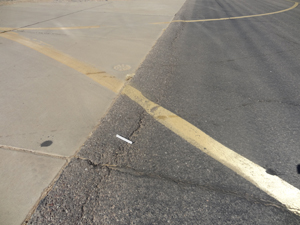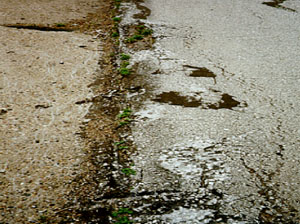Shoving
PCC pavements occasionally increase in length at ends where they adjoin flexible pavements (commonly referred to as "pavement growth"). This "growth" shoves the asphalt- or tar-surfaced pavements, causing them to swell and crack. The PCC slab "growth" is often caused by a gradual opening up of the joints as they are filled with incompressible materials that prevent them from reclosing.
| Severity | Distress Example | Description |
|---|---|---|
| Low |  | A slight amount of shoving has occurred, with little effect on ride quality and no break-up of the asphalt pavement. Height Differential: < 3/4 in (< 20 mm) |
| Medium |  | A significant amount of shoving has occurred, causing moderate roughness or break-up of the asphalt pavement. Height Differential: 3/4 to 1 1/2 in (20 to 40 mm) |
| High |  | A large amount of shoving has occurred, causing severe roughness or break-up of the asphalt pavement. Height Differential: > 1 1/2 in (> 40 mm) |